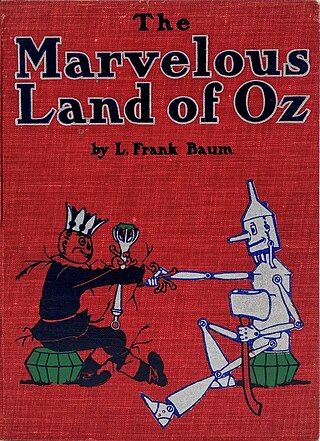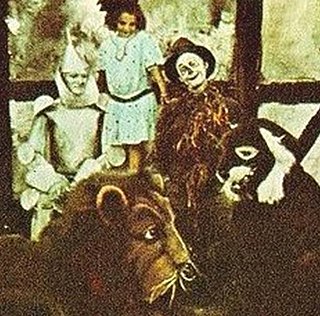Related Research Articles

Lyman Frank Baum was an American author best known for his children's fantasy books, particularly The Wonderful Wizard of Oz, part of a series. In addition to the 14 Oz books, Baum penned 41 other novels, 83 short stories, over 200 poems, and at least 42 scripts. He made numerous attempts to bring his works to the stage and screen; the 1939 adaptation of the first Oz book became a landmark of 20th-century cinema.

The Patchwork Girl of Oz is the seventh novel in L. Frank Baum's Oz series. Characters include the Woozy, Ojo "the Unlucky", Unc Nunkie, Dr. Pipt, Scraps, and others. The book was first published on July 1, 1913, with illustrations by John R. Neill. In 1914, Baum adapted the book to film through his Oz Film Manufacturing Company.

The Wonderful Wizard of Oz is a 1900 children's novel written by author L. Frank Baum and illustrated by W. W. Denslow. It is the first novel in the Oz series of books. A Kansas farm girl named Dorothy ends up in the magical Land of Oz after she and her pet dog Toto are swept away from their home by a cyclone. Upon her arrival in the magical world of Oz, she learns she cannot return home until she has destroyed the Wicked Witch of the West.

The Marvelous Land of Oz: Being an Account of the Further Adventures of the Scarecrow and the Tin Woodman, commonly shortened to The Land of Oz, published in July 1904, is the second book in L. Frank Baum's Oz series, and the sequel to The Wonderful Wizard of Oz (1900). This and the following 34 books in the series were illustrated by John R. Neill.

Ozma of Oz, published on July 30, 1907, was the third book of L. Frank Baum's Oz series. It was the first in which Baum was clearly intending a series of Oz books.

Nick Chopper, the Tin Woodman, is a character in the fictional Land of Oz created by American author L. Frank Baum. He first appeared in his 1900 book The Wonderful Wizard of Oz and reappeared in many other subsequent Oz books in the series. In late 19th-century America, men made out of various tin pieces were used in advertising and political cartoons. Baum, who was editing a magazine on decorating shop windows when he wrote The Wonderful Wizard of Oz, was inspired to invent the Tin Woodman by a figure he had built out of metal parts for a shop display.

The Land of Oz is a magical country introduced in the 1900 children's novel The Wonderful Wizard of Oz written by L. Frank Baum and illustrated by W. W. Denslow.

Tik-Tok is a fictional "mechanical man" from the Oz books by American author L. Frank Baum. He has been termed "the prototype robot", and is widely considered to be one of the first robots to appear in modern literature, though the term "Robot" was not used until the 1920s, in the play R.U.R.
Oz Squad is a comic book series using characters and setting from L. Frank Baum's Land of Oz series, "updated for a more adult audience". It was created and written by Steve Ahlquist. The premise is that Dorothy, the Scarecrow, the Tin Woodman and the Cowardly Lion are now part of "Gale Force", a Mission: Impossible type organization working to protect Oz from all manner of bizarre threats.

The Wizard of Oz is a 1925 American silent fantasy-adventure comedy film directed by Larry Semon, who also performs in the lead role as a Kansas farmhand disguised as the Scarecrow.

The Wonderful Wizard of Oz is a 1910 American silent fantasy film and the earliest surviving film version of L. Frank Baum's 1900 novel The Wonderful Wizard of Oz, made by the Selig Polyscope Company without Baum's direct input. It was created to fulfill a contractual obligation associated with Baum's personal bankruptcy caused by The Fairylogue and Radio-Plays, from which it was once thought to have been derived. It was partly based on the 1902 stage musical The Wizard of Oz, though much of the film deals with the Wicked Witch of the West, who does not appear in the musical.

The Wizard of Oz was a 1902 musical extravaganza based on the 1900 novel The Wonderful Wizard of Oz by L. Frank Baum. Although Baum is the credited bookwriter, Glen MacDonough was hired on as jokewriter after Baum had finished the script, and the book was largely ghostwritten by a man named Finnegan. Much of the original music was by Paul Tietjens and has been mostly lost, although it was still well-remembered and in discussion at MGM in 1939 when the classic film version of the story was made. The original show was particularly popular because of its two comedy stars: Fred Stone playing the Scarecrow, and David C. Montgomery as the Tin Woodman.

The Fairylogue and Radio-Plays was an early attempt to bring L. Frank Baum's Oz books to the motion picture screen. It was a mixture of live actors, hand-tinted magic lantern slides, and film. Baum himself would appear as if he were giving a lecture, while he interacted with the characters. Although acclaimed throughout its tour, the show experienced budgetary problems and folded after two months of performances. It opened in Grand Rapids, Michigan on September 24, 1908. It then opened in Orchestra Hall in Chicago on October 1, toured the country and ended its run in New York City. There, it was scheduled to run through December 31, and ads for it continued to run in The New York Times until then, but it reportedly closed on December 16.

The Patchwork Girl of Oz (1914) is a silent film made by L. Frank Baum's The Oz Film Manufacturing Company. It was based on the 1913 book The Patchwork Girl of Oz.

The Wonderful Wizard of Oz is a 1900 children's novel written by American author L. Frank Baum. Since its first publication in 1900, it has been adapted many times by L. Frank Baum and others: for film, television, theatre, books, comics, games, and other media.

The Wizard of Oz is a musical with a book by John Kane, music by Harold Arlen and lyrics by E. Y. Harburg. It has additional background music by Herbert Stothart. It is based on the 1900 novel The Wonderful Wizard of Oz by L. Frank Baum and the 1939 film version written by Noel Langley, Florence Ryerson and Edgar Allan Woolf.
The Wizard of Oz is a musical commissioned by The Muny based on the 1900 novel The Wonderful Wizard of Oz by L. Frank Baum and the 1939 film, The Wizard of Oz, using the film's songs by Harold Arlen and E. Y. Harburg. The book of the musical is by Frank Gabrielson, who would later write an adaptation of The Marvelous Land of Oz (1960) for Shirley Temple.

The Tik-Tok Man of Oz is a musical play with book and lyrics by L. Frank Baum and music by Louis F. Gottschalk that opened at the Majestic Theatre in Los Angeles, California on March 31, 1913. It is loosely inspired by Baum's book Ozma of Oz (1907), incorporates much of the material from Baum's book The Road to Oz (1909), and was the basis for his 1914 novel, Tik-Tok of Oz. It was promoted as "A Companion Play to The Wizard of Oz" and directed by Frank M. Stammers. The play is known from its advertising and published music, but survives only in earlier manuscript.
This is a complete bibliography for American children's writer L. Frank Baum.
References
- Swartz, Mark Evan. Oz Before the Rainbow: L. Frank Baum's 'The Wonderful Wizard of Oz' on Stage and Screen to 1939. The Johns Hopkins University Press, 2000 ISBN 0-8018-6477-1